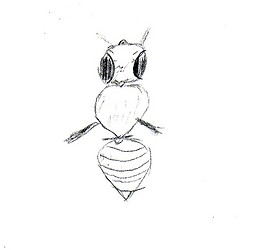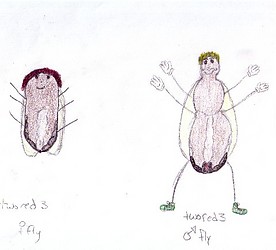Introduction
In this introduction we shall explain not only what experiment we did, but why. For our 10th grade science class, we decided to do experiments with fruit fly genetics. Why fruit flies you may ask...
- They mate and breed in a very fast manner
- The offspring mature quickly
- They are easy to fly nap!
The reason we were studying fruit fly mutations was because we were/are learning about genes, alleles and overall genetic traits. This experiment was designed to help us (and hopefully you) understand dominant and recessive genes better. We started by breeding purebred mutated flies with purebred wildtype flies. We did this so that we could see by their offspring which gene is dominant and which is recessive. We determined this by viewing which flies had which phenotypes (physical characteristics). The following are records of our experiment.
Characteristics
First of all these are the characteristics of the Drosophila melanogaster.
Phylum: Arthropoda are segmented and have exoskeletons. Most have antennae. All have open circulatory systems, and all have mandibles.
Class: Insecta have 3 Lagmata: Head, Thorax, and Abdomen. Abdomen has 9 to 11 segments. Only one pair of antennae.
Order: Diptera have one pair of wings, and specialized mouth parts.
Drosophila Phenotypes
Before diving into personal experiences, we should clarify the differences between the Phenotypes(Physical attributes) we were working with. The first is the standard wild type (designated by +).
Wild type flies are just your normal, average, everyday fruit flies. With full and petal-like wings and red eyes.
The second Phenotype is Vestigial wings(Designated by Vg). Flies with the Vestigial mutation have shriveled up wings which jut out to the sides(Above). A pure bread Vestigial has red eyes like the wild type.
The last Phenotype we had direct contact with was the White Eyes mutation(Designated by W). The White Eyes is pretty self explanatory. The fly has white eyes as opposed to the standard red.
There are many other mutations, but we did not deal with them.
Life Cycle Log
Over the course of our experiment, we kept a consistent log, recording the changes and lives of our flies. There are three separate logs, keeeping track of the original parent flies, generation f1 and generation f2.
| Date | Parent flies observations |
| 2/27/06 | Flies expanded to new cultures. |
| 3/2/06 | no sign of larvae, medium dry, added water. |
| 3/3/06 | Saw larva :little translucent worm things with a black/grey dot by the head. We can see them burrowing. |
| 3/7/06 | There's a lot more larvae than yesterday. Almost all the larvae are at the top of the medium. |
| 3/9/06 | Many pupae |
| 3/10/06 | Pupae are about to hatch, we can tell because the pupa is dark |
| 3/13/06 | About half of the pupas are ready to hatch. Not very many larvae. |
| 3/16/06 | Vial 2 one Vg male died, vial 1 one wild male died. |
| 3/17/06 | Looks like some eggs were laid. |
| 3/20/06 | Medium looks dry. 2 dead in vial 1, 1 dead in vial 2. |
| 3/21/06 | Vial 1 pupae are forming(day old) Vial 2 lot of larva, no pupa yet, still only one dead fly. |
| 3/23/06 | vial 1 and vial 2 lots of pupae, vial 1 another fly dead(cannot tell gender)not very many larvae. |
| 3/24/06 | Almost all pupae in vial 1 are dark, in vial 2 only half are dark |
| 3/27/06 | In both vials there are a lot of flies in both vials. There are only wild. |
| 3/28/06 | "There's a load of flies"-twored4) Only see wild, no vestigial in either vial. |
| 3/30/06 | "Holy cow there's a lot of flies"- (twored4) still no vestigial. (pictured below) |
| 3/31/06 | today napped all flies(all wild) and selected 6 males and 6 females for each new vial(beginning of F1 cross) |
| DATE | F1 Cross observations |
| 3/31/06 | New flies in their new vials. |
| 4/3/06 | Only 3 alive in vial 2(all female), in vial one 4 have died(2 males,1 female, 1 mystery). Added 3 females and 6 males to vial 2. |
| 4/6/06 | all females are pregnant(it looks like)in both vials. There are larvae in both vials, but more in vial 1 |
| 4/7/06 | Today we cleared out all F1's (living and dead) in both vials. Many larvae and pupae in vials 1 and 2. (These pupa and larva are the start of F2. |
| 4/7/06 to 4/25/06 | Recorded # of flies every day and cleared them all afterwards every other day. Table with fly phenotype# located below. |
Sexing The Flies
- First you have to tap the vial of flies on the table so the flies fall to the bottom and they don't fly away.
- Then you have to put the fly nap wand in the vial making sure not to get fly nap on the foam cap.
- Next all the flies fall asleep, and you dump the flies out on an index card (below).
- Finally, separate the male flies from the female flies. You can tell the difference between a male and female fly by looking at their abdomens. A male fly will have a thick dark crescent at the bottom of the abdomen, while female flies have a sliver of black at the bottom, they also have a white patch above the sliver.
F1 Predictions
If the mutation for vestigial (vg) is autosomal dominant and wild (+) is recessive, then the phenotype will be 100% vestigial and then genotype will be vg+ (heterozygous).
| Vg | Vg | |
| + | Vg+ | Vg+ |
| + | Vg+ | Vg+ |
If the wild (+) is autosomal dominant and vestigial (vg) is recessive, then the phenotype will be 100% wild and the genotype will be 100% +vg (heterozygous).
| + | + | |
| Vg | Vg+ | Vg+ |
| Vg | Vg+ | Vg+ |
If the mutation for vestigial (vg) is sex-linked and dominant and the wild (+) is recessive then when the mutation is on the female then the phenotype will be: 50% vestigial male and 50% vestigial female. The genotype will be: 50% XvgX+ heterozygous and 50% XvgY.
| + | + | |
| Vg | +Vg | +Vg |
| Vg | +Vg | +Vg |
If the mutation is on the male then the phenotype will be: 50% vestigial female and 50% wild type male. The genotype will be: 50% XvgX+ heterozygous and 50% X+Y.
| Vg | Vg | |
| + | +Vg | +Vg |
| + | +Vg | +Vg |
If the wild (+) is sex-linked and dominant and the mutation for vestigial (vg) is recessive, then when the mutation is on the female phenotype will be: 50% wild type female and 50% vestigial male and the genotype will be: 50% X+Xvg heterozygous and 50% XvgY+
| Xvg | Xvg | |
| X+ | XvgX+ | XvgX+ |
| Y | XvgY | XvgY |
If the mutation is on the male then the phenotype will be: 50% wild type female and 50% wild type male. The genotype will be: 50% X+Xvg heterozygous and 50% X+Y.
| X+ | X+ | |
| Xvg | X+Xvg | X+Xvg |
| Y | X+Y | X+Y |
If the wild is sex-linked and dominant and the mutation for vestigial (vg) is recessive, then when the mutation is on the female the phenotype will be: 50% wild type female and 50% vestigial male. The genotypes will be: 50% X+Xvg heterozygous female and 50% XvgY.
| Xvg | Xvg | |
| X+ | X+Xvg | X+Xvg |
| Y | XvgY | XvgY |
If the mutation is on the male then the phenotype will be: 50% wild type female and 50% wild type male. The genotype will be: 50% X+Xvg heterozygous and 50% X+Y
| X+ | X+ | |
| Xvg | X+Xvg | X+Xvg |
| Y | X+Y | X+Y |
F1 Outcomes
All offspring of purebred Wildtype and purebred Vestigial(male and female of both ++ and vgvg) were wild type, hinting that the Vestigial mutation is autosomal recessive.
F2 Predictions
Based on our F1 results, we hypothesized that the vestigial mutation is autosomal recessive.
In vial 1 we had 6 males and 6 females, which we predicted were all +vg (heterozygous wild). The following is the punnett square which we based our predictions on:
| + | vg | |
| + | ++ | +vg |
| vg | +vg | vgvg |
Which would mean that The Phenotypes of the offspring would be 75% Wild and 25% Vestigial, and the Genotypes of said offspring would be 25% +++vgvg, and 50%+vg.
Being as vial 2 had the 6 males and 6 females from F1, our predictions remain the same for vial 2
F2 Outcome Tables
Vial 1
| Date F2 Counted | Female Wild+ | Male Wild+ | Female Vestigial VG | Male Vestigial VG |
| 4/17/06 | 63 | 50 | 8 | 20 |
| 4/20/06 | 25 | 28 | 8 | 13 |
| 4/21/06 | 9 | 4 | 1 | 5 |
| 4/24/06 | 25 | 20 | 4 | 4 |
| 4/25/06 | 12 | 110 | 6 | 5 |
| Total 320 | 134 | 112 | 27 | 47 |
Vial 2
| Date F2 Counted | Female Wild+ | Male Wild+ | Female Vestigial VG | Male Vestigial VG |
| 4/17/06 | 51 | 30 | 6 | 14 |
| 4/20/06 | 26 | 11 | 10 | 10 |
| 4/21/06 | 1 | 3 | 0 | 1 |
| 4/24/06 | 13 | 9 | 5 | 6 |
| 4/25/06 | 12 | 14 | 4 | 7 |
| Total 233 | 103 | 67 | 25 | 38 |
Percent Error
Vial 1
| Phenotype | Observed | Expected | (O-E) | (O-E)/E | X100 | % Error |
| Wild | 246 | 240 | 6 | .025 | 2.5 | 2.5% |
| Vestigial | 74 | 80 | 6 | .075 | 7.5 | 7.5 |
Vial 2
| Phenotype | Observed | Expected | (O-E) | (O-E )/E | X100 | % Error |
| Wild | 170 | 174.75 | 4.75 | .0272 | 2.72 | 2.72% |
| Vesgitial | 63 | 58.25 | 4.75 | .0815 | 8.15 | 8.15% |
Conclusion
Through our data we can tell that our hypothesis was correct, that if original parents being an equal number vestigial and wild mate, then the offspring by generation 2 will be 25% vestigial homozygous, 25% wild type homozygous, and 50% wild type heterozygous, meaning that the mutation of vestigial wings is autosomal recessive.
Some problems that we encountered were flies being buried in the medium, which would cause some data to be skewed being as we couldn't retrieve them. In order to avoid this problem we found that keeping the vial on its side helped.
Eulogy
During the course of our experiment we had to kill many fruit flies, so we have this to say:
They were flies, they flied and they flied,
They stood for a noble cause, but all of them died.







 Go to quick links
Go to quick search
Go to navigation for this section of the ToL site
Go to detailed links for the ToL site
Go to quick links
Go to quick search
Go to navigation for this section of the ToL site
Go to detailed links for the ToL site